Based in Glenmore, Co Kilkenny, the Hartley family runs a large contracting business alongside milking a herd of 100 cows. Three years ago, after being approached by the local co-operative and some farmers, the family looked into the option of purchasing a zero-grazing machine for hire work.
They felt it would complement their large contracting business and also benefit their own dairy farm.
Thomas explained that in the spring of 2016 they travelled to the FTMTA Farm Machinery Show in Punchestown with the intent of checking out zero-grazing machines.
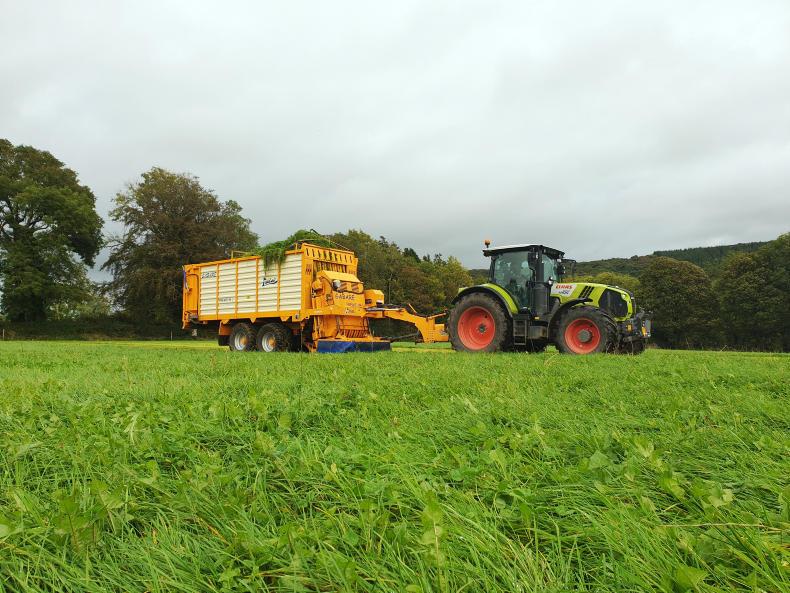
A feature new to this machine is the ability to adjust the height of the body from the ground.
After analysing what was on offer, the family followed up by visiting a number of different machines out working. In the end, they felt the Bélair was the strongest built machine from a contractor perspective. After agreeing a deal, they took delivery of their Bélair zero-grazing machine soon after the show in May 2016. The machine in question was a 2740-2. The Hartleys traded it in two months ago for a new machine, this time opting for the new Premium L model.
Workload
The Hartleys said that their zero-grazing workload has grown year on year and has really added to their contracting business. Thomas explained that typically the machine goes to work in the first week of January, runs continuously until the end of May, is back out again before the end of June and, weather permitting, will operate right up until Christmas. This keeps a tractor busy for most of the year, and allows it to go at silage for a few weeks in June.
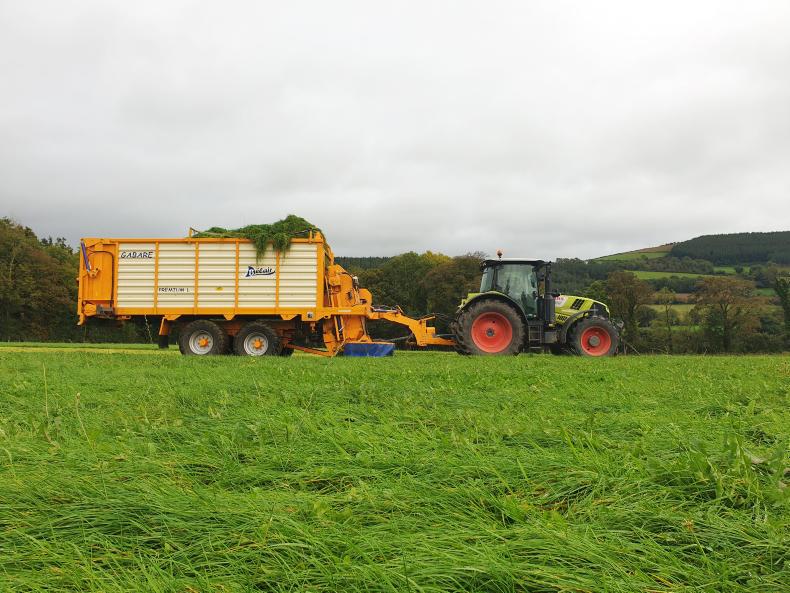
The Hartleys typical draw from the field to the yard is about five miles each way.
In addition to cutting grass with the machine, the Hartleys noted how last autumn it was also used to cut kale and rape. Despite some people saying the elevator in a zero-grazing machine would mulch catch crops, the Hartleys didn’t encounter this problem.
Thomas added that all of his customers are dairy farmers. The most surprising thing is distance over which they draw grass each day. He said: “Our typical draw from the field to the yard is about five miles each way. The furthest we draw grass is up to 10 miles each way. This is why we needed a machine that was built heavy with high-speed axles.”
They also work for some customers who run their own forage wagons. Thomas puts this down to the zero-grazing machine being lighter on the ground and easier on the grass.
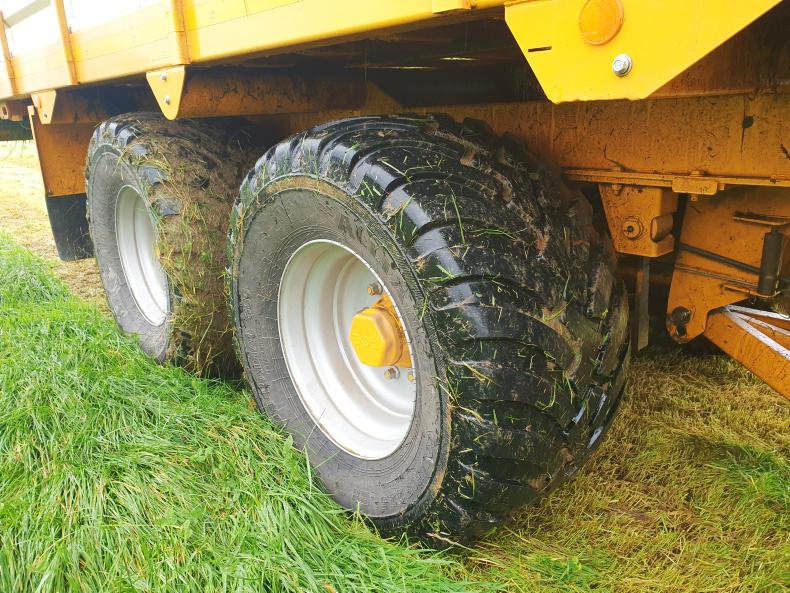
The Hartley’s new Belair is shod on 600/50 R22.5 tyres.
Due to the long draws, the Hartleys charge on a per-hour basis from when they leave their own yard until they leave the customer’s yard. They feel that charging by the hour is the fairest way for both the contractor and farmer. Charging by the load can vary hugely depending on the distance between the yard and the fields and the time it may take to fill a load whether the crop is heavy or light.
Mower/elevator
The Premium L zero-grazing machine features a Galfre two-drum mowing unit found commonly on a number of these types of machines. Each drum has four reversible blades which offer a 2.25 metre cutting width.
Thomas noted that they did look at other brands that were running disc mowers but he felt the drum mower worked better in shorter grass.
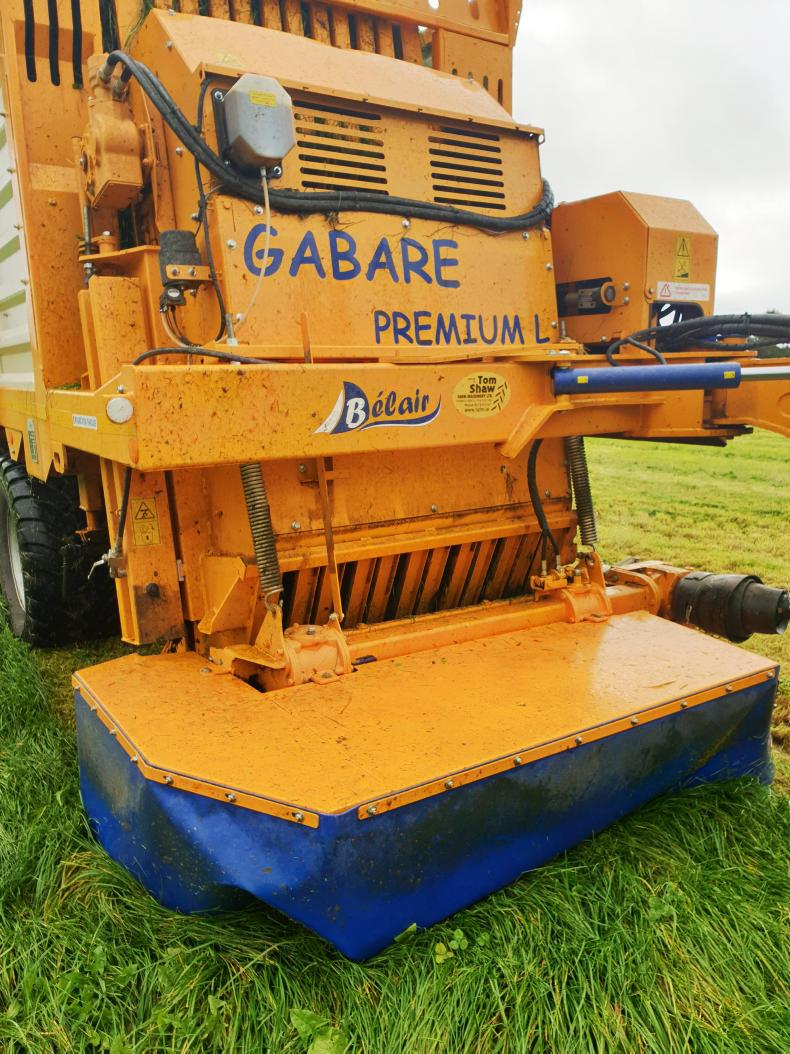
The Premium L zero-grazing machine features a Galfre two-drum 2.25 metre mowing unit.
However, he does feel that in the long term, we will see more and more zero-grazing machines being equipped with disc mowers because they have less maintenance.
Bélair’s elevator system is hydraulically driven. Thomas noted that most other brands on the market are PTO driven and have slip clutches and shear pins. However, the Bélair elevator system has a regulator valve which will cut out if it becomes overloaded. The operator then stops momentarily, and rotates the floor a little to clear the blockage.

The back door sees a redesigned latch and ram closing system.
Thomas said Bélair has made a number of changes to the machine in the time between his 2016 machine and his new machine. He said the machine is approximately four to six inches wider and it’s a foot lower. The mowing unit and the elevator are now separate, which allows the mower to follow the contours of the ground better.

The hydraulic motor is the widest point, sitting out at the side of the machine. The Hartleys made a frame to protect it.
He said the elevator is now bigger, and as a result has an increased throughput, getting blocked less often. The machine also has more ground clearance than its predecessor, helping the mower not to get caught on ground entering or exiting low-lying gaps.
Flotation
The Hartleys’ new Bélair is shod on 600/50 R22.5 tyres. This is a step up from their older machine that sat on 580/50 R22.5s. Their new machine also sees the addition of a much welcomed steering axle.
This is hydraulically engaged and disengaged via the electro-hydraulic control terminal.
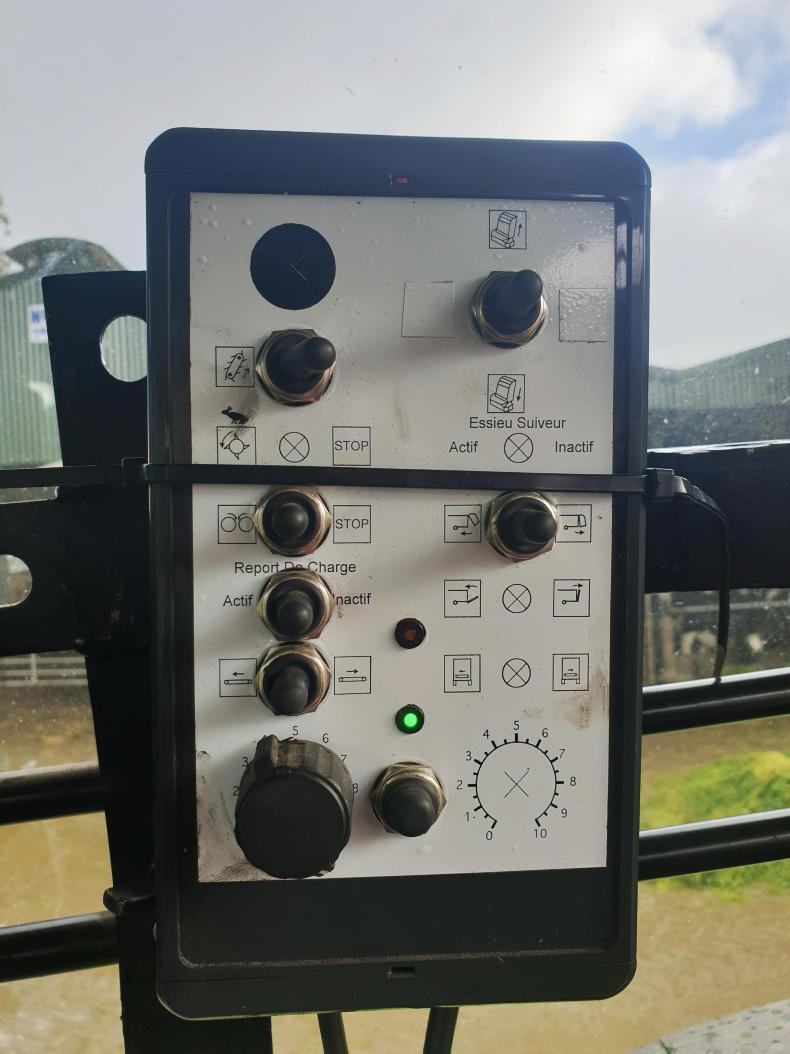
The machine requires three spool valves and an electro-hydraulic control box to operate it.
Thomas noted that in the future he would love to see the machine being equipped with a forced steering axle, similar to what’s on some silage trailers and many rakes on today’s market. The axles on the new Premium L models have been moved forward in comparison to the previous machine the Hartleys had. Thomas said this is a big help in getting in and out of fields with tight gaps.

John Hennessy, Thomas Hartley and PJ Hartley.
The Hartleys are pulling the zero-grazing machine with their new Claas Arion 650. They said the machine is suited to this 50km/h rated tractor; it’s sitting on heavy-duty high-speed axles which are on springs.
Thomas said: “A 120hp tractor would drive the machine in normal conditions no problem.

The mowing unit and the elevator are now separate, which allows the mower to follow the contours of the ground better.
But when working in hilly conditions with the machine running offset towards the shoulders of the year, you need weight or the tractor will get bullied around. For comfort, you need a minimum of 150hp”.
Another feature new to this machine is the ability to adjust the height of the body from the ground. This is done with a ram which pressurises the body of the machine down against the axle, allowing either side of the machine to be raised if working on hilly conditions. It’s a feature that has impressed the Hartleys, especially as they work on quite a bit of hilly ground.
Bélair is a family-owned French company. Established in 1964, it employs more than 45 people. They manufacture a range of forage and feeding equipment.

The back door sees a redesigned latch and ram closing system.
The company is based in Brittany. Tom Shaw Machinery, Birr, Co Offaly, is the importer and distributor for the Bélair zero-grazing machines in Ireland.
Bélair the
strongest-built
contractor-spec
zero-grazing machine
Thomas said he really likes the Bélair machine. He explained that after examining all brands available on the Irish market three years ago when they purchased their first machine, and looking at the market again this spring, they are adamant that the Bélair is still the heaviest-built contractor-spec zero-grazing machine on the market.
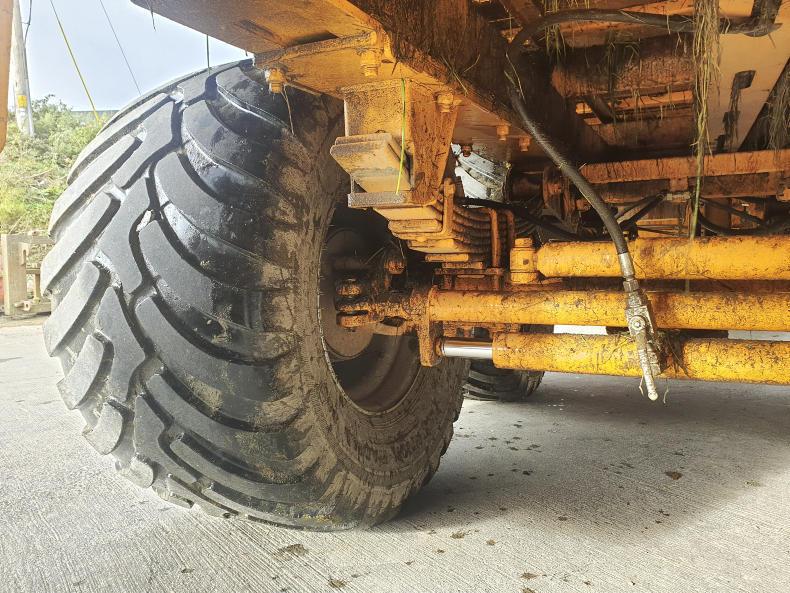
The Hartleys new Belair has a steering axle.
However, he also says that despite the many improvements Bélair has made on its highest-spec offering in the three years between purchasing the two machines, there are still some areas that could be further enhanced.
The spec
Model: Bélair Premium L
Mower unit:Galfre two-drum mowing unit
Cutting width: 2.25 metres
Tyres: 600-50/22.5 on steering axle
Weight: 4,900kg
Price: €50,000 including VAT (depending on spec).
Based in Glenmore, Co Kilkenny, the Hartley family runs a large contracting business alongside milking a herd of 100 cows. Three years ago, after being approached by the local co-operative and some farmers, the family looked into the option of purchasing a zero-grazing machine for hire work.
They felt it would complement their large contracting business and also benefit their own dairy farm.
Thomas explained that in the spring of 2016 they travelled to the FTMTA Farm Machinery Show in Punchestown with the intent of checking out zero-grazing machines.

A feature new to this machine is the ability to adjust the height of the body from the ground.
After analysing what was on offer, the family followed up by visiting a number of different machines out working. In the end, they felt the Bélair was the strongest built machine from a contractor perspective. After agreeing a deal, they took delivery of their Bélair zero-grazing machine soon after the show in May 2016. The machine in question was a 2740-2. The Hartleys traded it in two months ago for a new machine, this time opting for the new Premium L model.
Workload
The Hartleys said that their zero-grazing workload has grown year on year and has really added to their contracting business. Thomas explained that typically the machine goes to work in the first week of January, runs continuously until the end of May, is back out again before the end of June and, weather permitting, will operate right up until Christmas. This keeps a tractor busy for most of the year, and allows it to go at silage for a few weeks in June.

The Hartleys typical draw from the field to the yard is about five miles each way.
In addition to cutting grass with the machine, the Hartleys noted how last autumn it was also used to cut kale and rape. Despite some people saying the elevator in a zero-grazing machine would mulch catch crops, the Hartleys didn’t encounter this problem.
Thomas added that all of his customers are dairy farmers. The most surprising thing is distance over which they draw grass each day. He said: “Our typical draw from the field to the yard is about five miles each way. The furthest we draw grass is up to 10 miles each way. This is why we needed a machine that was built heavy with high-speed axles.”
They also work for some customers who run their own forage wagons. Thomas puts this down to the zero-grazing machine being lighter on the ground and easier on the grass.

The Hartley’s new Belair is shod on 600/50 R22.5 tyres.
Due to the long draws, the Hartleys charge on a per-hour basis from when they leave their own yard until they leave the customer’s yard. They feel that charging by the hour is the fairest way for both the contractor and farmer. Charging by the load can vary hugely depending on the distance between the yard and the fields and the time it may take to fill a load whether the crop is heavy or light.
Mower/elevator
The Premium L zero-grazing machine features a Galfre two-drum mowing unit found commonly on a number of these types of machines. Each drum has four reversible blades which offer a 2.25 metre cutting width.
Thomas noted that they did look at other brands that were running disc mowers but he felt the drum mower worked better in shorter grass.

The Premium L zero-grazing machine features a Galfre two-drum 2.25 metre mowing unit.
However, he does feel that in the long term, we will see more and more zero-grazing machines being equipped with disc mowers because they have less maintenance.
Bélair’s elevator system is hydraulically driven. Thomas noted that most other brands on the market are PTO driven and have slip clutches and shear pins. However, the Bélair elevator system has a regulator valve which will cut out if it becomes overloaded. The operator then stops momentarily, and rotates the floor a little to clear the blockage.

The back door sees a redesigned latch and ram closing system.
Thomas said Bélair has made a number of changes to the machine in the time between his 2016 machine and his new machine. He said the machine is approximately four to six inches wider and it’s a foot lower. The mowing unit and the elevator are now separate, which allows the mower to follow the contours of the ground better.

The hydraulic motor is the widest point, sitting out at the side of the machine. The Hartleys made a frame to protect it.
He said the elevator is now bigger, and as a result has an increased throughput, getting blocked less often. The machine also has more ground clearance than its predecessor, helping the mower not to get caught on ground entering or exiting low-lying gaps.
Flotation
The Hartleys’ new Bélair is shod on 600/50 R22.5 tyres. This is a step up from their older machine that sat on 580/50 R22.5s. Their new machine also sees the addition of a much welcomed steering axle.
This is hydraulically engaged and disengaged via the electro-hydraulic control terminal.

The machine requires three spool valves and an electro-hydraulic control box to operate it.
Thomas noted that in the future he would love to see the machine being equipped with a forced steering axle, similar to what’s on some silage trailers and many rakes on today’s market. The axles on the new Premium L models have been moved forward in comparison to the previous machine the Hartleys had. Thomas said this is a big help in getting in and out of fields with tight gaps.

John Hennessy, Thomas Hartley and PJ Hartley.
The Hartleys are pulling the zero-grazing machine with their new Claas Arion 650. They said the machine is suited to this 50km/h rated tractor; it’s sitting on heavy-duty high-speed axles which are on springs.
Thomas said: “A 120hp tractor would drive the machine in normal conditions no problem.

The mowing unit and the elevator are now separate, which allows the mower to follow the contours of the ground better.
But when working in hilly conditions with the machine running offset towards the shoulders of the year, you need weight or the tractor will get bullied around. For comfort, you need a minimum of 150hp”.
Another feature new to this machine is the ability to adjust the height of the body from the ground. This is done with a ram which pressurises the body of the machine down against the axle, allowing either side of the machine to be raised if working on hilly conditions. It’s a feature that has impressed the Hartleys, especially as they work on quite a bit of hilly ground.
Bélair is a family-owned French company. Established in 1964, it employs more than 45 people. They manufacture a range of forage and feeding equipment.

The back door sees a redesigned latch and ram closing system.
The company is based in Brittany. Tom Shaw Machinery, Birr, Co Offaly, is the importer and distributor for the Bélair zero-grazing machines in Ireland.
Bélair the
strongest-built
contractor-spec
zero-grazing machine
Thomas said he really likes the Bélair machine. He explained that after examining all brands available on the Irish market three years ago when they purchased their first machine, and looking at the market again this spring, they are adamant that the Bélair is still the heaviest-built contractor-spec zero-grazing machine on the market.

The Hartleys new Belair has a steering axle.
However, he also says that despite the many improvements Bélair has made on its highest-spec offering in the three years between purchasing the two machines, there are still some areas that could be further enhanced.
The spec
Model: Bélair Premium L
Mower unit:Galfre two-drum mowing unit
Cutting width: 2.25 metres
Tyres: 600-50/22.5 on steering axle
Weight: 4,900kg
Price: €50,000 including VAT (depending on spec).












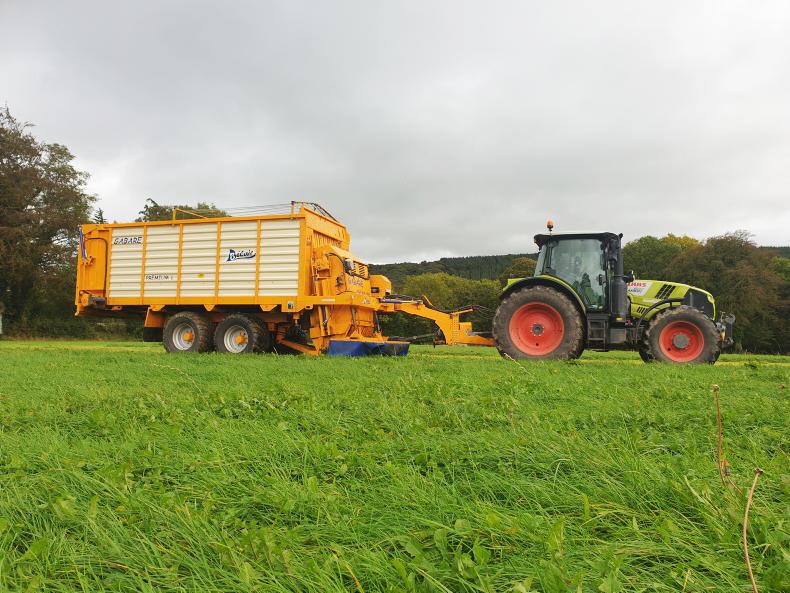




 This is a subscriber-only article
This is a subscriber-only article





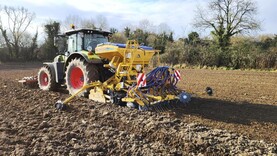
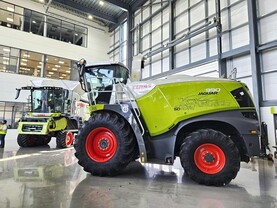
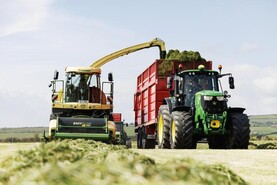


SHARING OPTIONS: